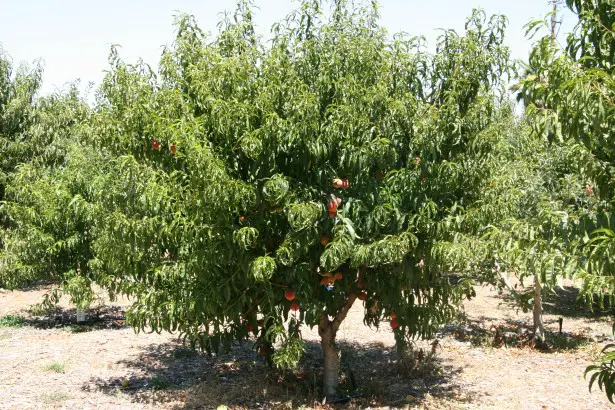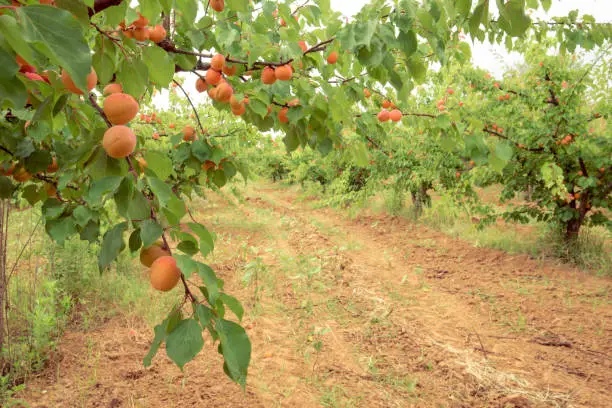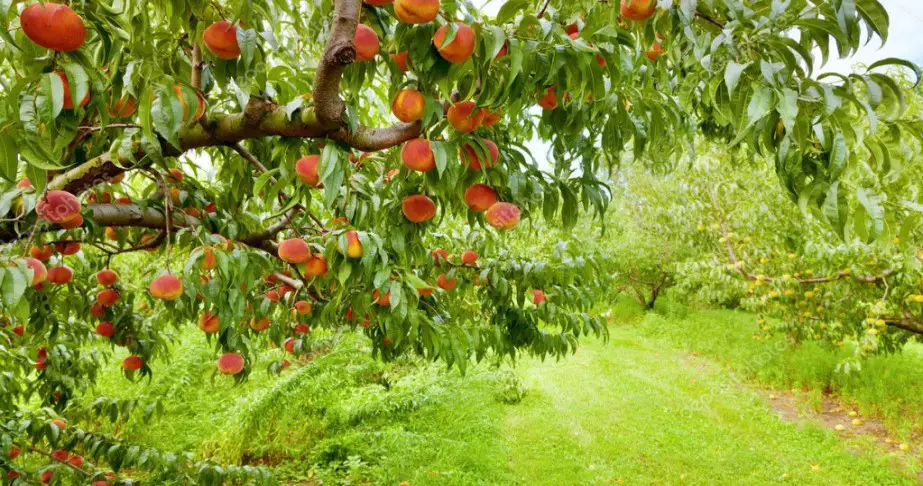Peach trees (prunus persica) are beautiful trees and marvels of nature.
They require specific conditions to thrive and prefer well-drained soil with a pH ranging from 6.0 to 6.5.
The trees demand an environment that nurtures their roots and suppresses the encroachment of weeds.
And that’s where the magic of mulch comes into play.
Mulching is a valuable practice that helps create optimal growing conditions by retaining moisture, enriching soil nutrients, and maintaining a balanced pH level.
Best Mulches for Peach Trees
1. Wood Chips
They offer several benefits to the trees and the soil. One of the key advantages of wood chips is their ability to conserve moisture.
By forming a protective layer over the soil, wood chips reduce evaporation and help the soil retain water, which is crucial for the hydration of peach trees.
They also act as an insulator, regulating soil temperature and protecting the roots of peach trees from extreme heat or cold.
As wood chips gradually break down, they release nutrients into the soil, contributing to its fertility.
- Application
When applying the chips around peach trees, ensure a layer with a depth of 3-4 inches, starting a few inches away from the trunk and extending to the drip line.
Related: Oak Mulch Pros and Cons
2. Straw
This is an excellent option for weed suppression and moisture retention around peach trees.
Its loose structure helps prevent the growth of weeds by blocking sunlight and inhibiting their germination.
Straw also acts as a protective barrier against soil erosion, keeping the soil intact around the tree’s roots.
Furthermore, straw mulch helps regulate soil temperature by insulating the soil and protecting it from extreme temperature fluctuations.
- Application
Create a layer approximately 4-6 inches thick around the tree to ensure that it’s a few inches away from the trunk to avoid excessive moisture retention against the bark.

3. Compost
Compost serves as a nutrient-rich mulch that enhances soil structure and fertility, making it an excellent choice for peach trees.
It provides slow-release nutrients to the trees, ensuring a steady supply of essential elements for their growth and productivity.
This mulch option also helps retain moisture in the soil and reduces the frequency of irrigation.
It acts as a natural weed suppressor that prevents weed growth around peach trees.
- Application
Create a layer with a depth of 2-3 inches around the tree. Avoid direct contact with the trunk.
4. Gravel
It offers unique benefits for peach trees, particularly in terms of weed control and moisture conservation.
The compact nature of gravel prevents weed growth by limiting sunlight penetration and inhibiting weed seeds from germinating.
Gravel also allows water to penetrate easily into the soil, which reduces surface runoff and promotes water absorption by the tree’s roots.
This characteristic makes gravel mulch an effective choice for conserving soil moisture, especially in dry regions.
- Application
Spread a layer approximately 2-3 inches thick around the tree. Ensure that it covers the area within the drip line.
Related: Best Mulches for Citrus Trees in Pots
5. Rubber Mulch
Made from recycled tires, rubber mulch is a long-lasting and low-maintenance option for peach trees.
One of its primary advantages is its ability to effectively suppress weed growth, similar to other inorganic mulches.
Rubber mulch acts as a barrier that prevents sunlight from reaching the soil and inhibits weed germination.
It also conserves moisture by reducing water evaporation from the soil surface. Its durability ensures a long lifespan, reducing the need for frequent replacement.
- Application
Apply a layer of rubber mulch with a depth of 2-3 inches around the tree. Make sure that it covers the root zone adequately.

6. Landscape Fabric
Landscape fabric is a permeable material that acts as a physical barrier that prevents weed growth while allowing water and air to pass through.
It offers excellent weed suppression and reduces competition for nutrients and resources between weeds and peach trees.
Landscape fabric also helps conserve soil moisture by reducing evaporation.
It’s particularly useful in orchards where peach trees are planted in rows, as it can be easily installed and maintained.
- Application
Place it around the tree, securing it with stakes or pins. Cut holes in the fabric to accommodate the tree’s trunk and allow for proper growth.
Related: Top 5 Recommended Mulch for Apple Trees
Factors to Consider When Choosing Mulch for Peach Trees
Consider the following factors when selecting the best mulch for your peach trees.
Water Retention
Peach trees require consistent moisture levels to thrive.
Mulch plays a vital role in water conservation by reducing evaporation and maintaining soil moisture.
Opt for mulches that effectively retain water, such as wood chips, straw, and compost.
Weed Suppression
Weeds compete with the trees for nutrients, water, and sunlight.
Choosing mulches that effectively suppress weed growth will alleviate this competition and reduce maintenance efforts.
Wood chips, straw, rubber mulch, and landscape fabric are great options for weed control.
Nutrient Enrichment
Organic mulches break down over time, enriching the soil with essential nutrients.
Consider mulch options like compost and wood chips that contribute to soil fertility and support the healthy growth of peach trees.

pH Balance and Soil Health
Maintaining the correct pH balance is crucial for peach tree health.
Some mulches, such as pine needles or pine bark, can slightly acidify the soil, which is beneficial for peach trees that prefer slightly acidic conditions.
Take into account the impact of mulch on soil pH and choose accordingly.
Related: Is Cedar Mulch Good for Fruit Trees? Yes, because…
Application Techniques for Mulching Peach Trees
Applying mulch correctly is as important as selecting the right type. Follow these guidelines for optimal results.
Preparing the Area
Clear the area around the base of the peach tree from weeds and grass. Ensure a clear space of about 3-4 inches in diameter around the trunk.
Proper Mulch Depth
Apply mulch in a layer approximately 2-4 inches deep, extending out to the dripline of the tree.
Avoid piling mulch against the trunk, as this can lead to moisture retention and potential rot.
Mulching Frequency and Maintenance
Replenish mulch as needed to maintain the recommended depth. Check periodically for weeds and remove any that emerge.
Also, monitor moisture levels to ensure that the soil doesn’t become waterlogged or excessively dry.
Mulching Dos and Don’ts
Don’t create a volcano-like mound of mulch against the trunk, as this can promote diseases.
Also, avoid using fresh wood chips that may deplete soil nitrogen as they decompose. Instead, opt for aged or composted wood chips.
Related
- Best Gravels to Walk on Bare Feet
- 10 Best Mulch for Wet Areas
- Top 7 Disadvantages of Decomposed Granite
- Grass Mulching Pros and Cons
- Gorilla Hair Mulch Pros and Cons
- Best Mulch for Perennials
- Where to Get Wood Chips for Gardens
- Best Mulch for Raised Vegetable Bed Garden
- Top 10 Wholesale Mulch Suppliers
- Top 10 Places Where to Buy Roof Gravel
- Best Cedar Mulch for a Vegetable Garden
- 5 Best Mulches for Apple Trees
- 6 Best Mulches for Cherry Trees (Organic & Inorganic)


